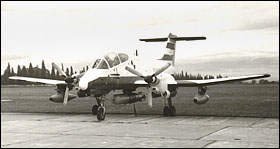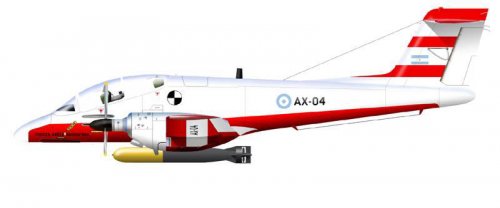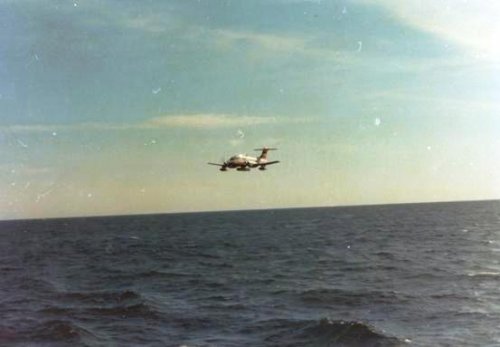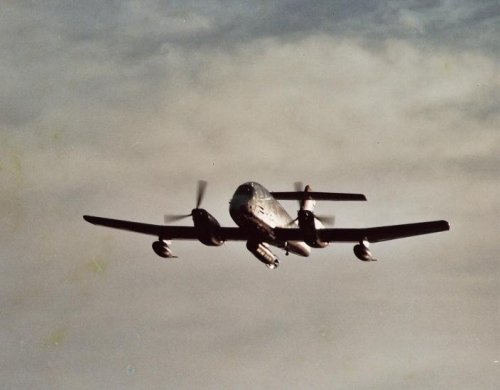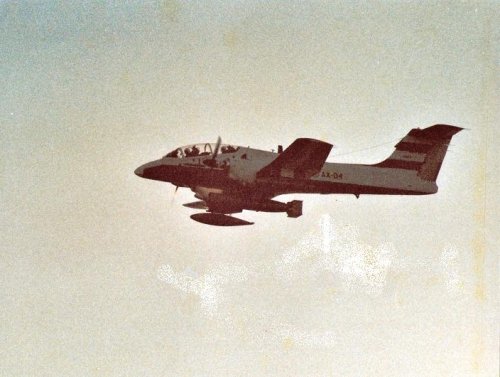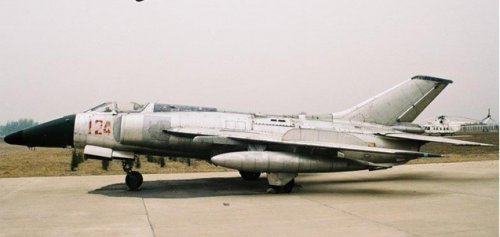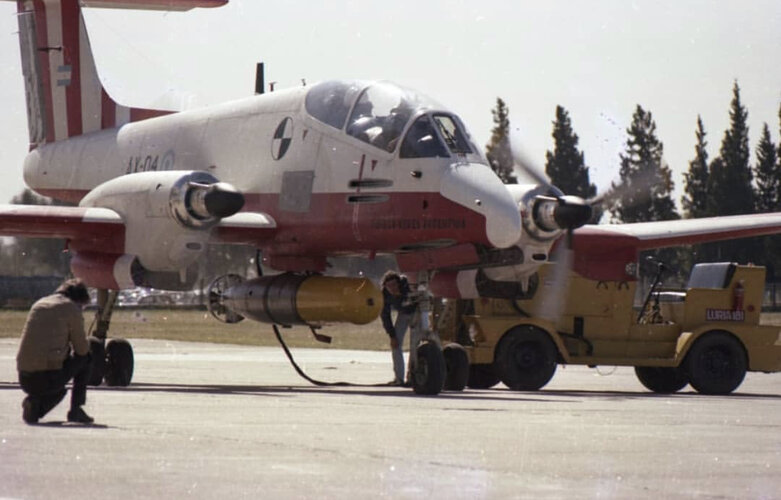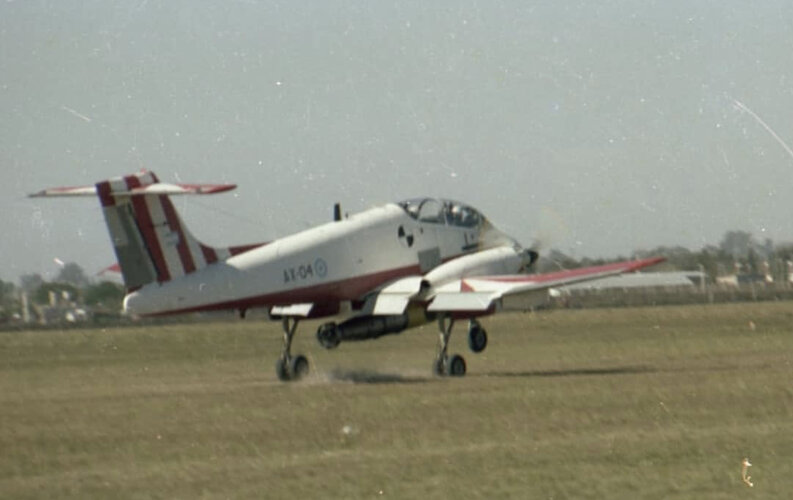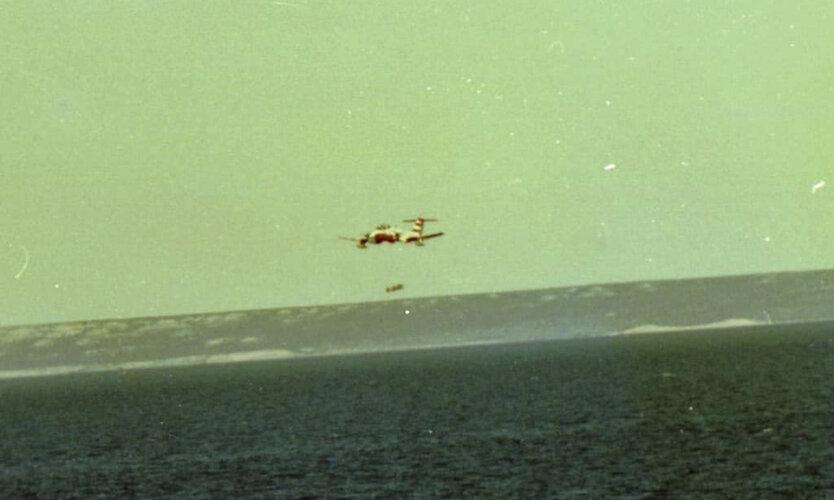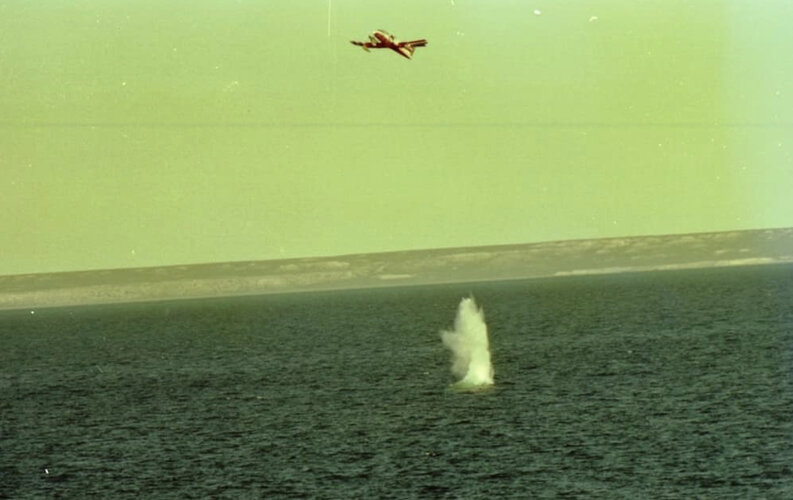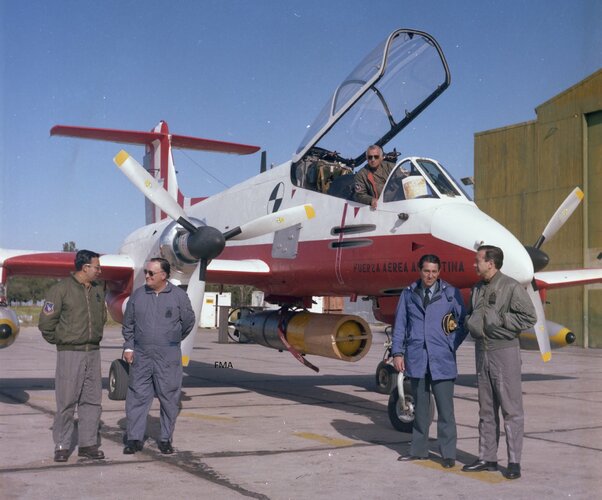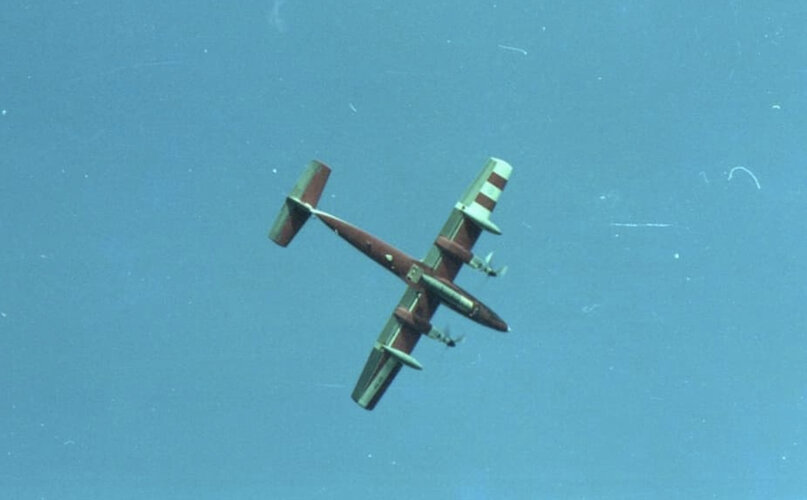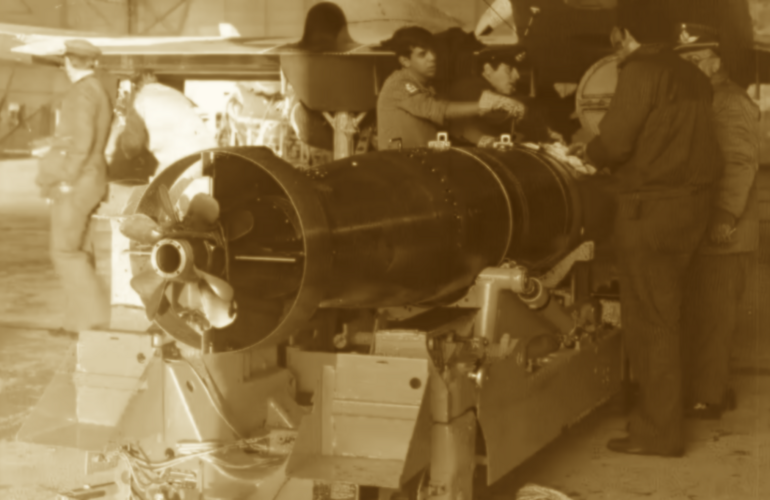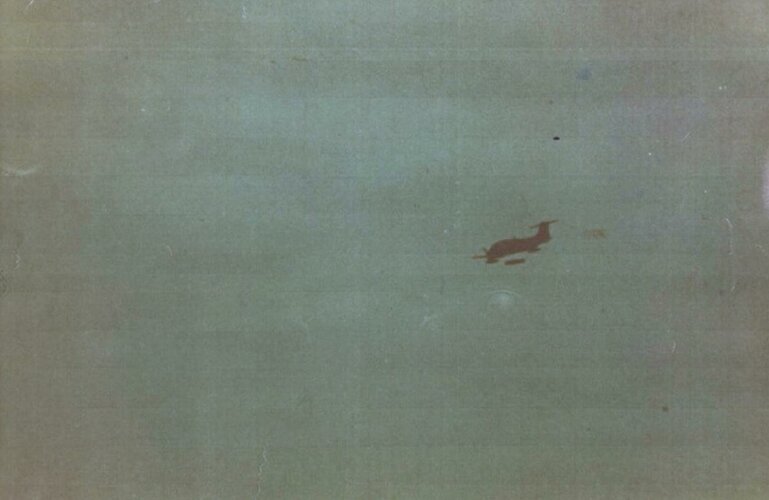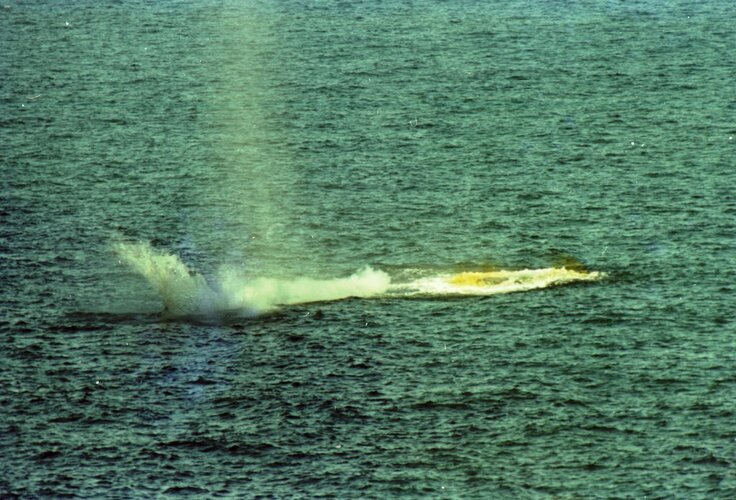- Joined
- 9 October 2009
- Messages
- 21,969
- Reaction score
- 13,616
Could the IA-58 Pucará be classified as the last Torpedo Bomber, at least developmental wise, of the 20th Century?
For those of you who are not familiar with it, AX-04 was a prototype of the IA 58 Pucará, modified during the Falklands War as part of a joint Air Force/Navy project hoping to improve the anti-ship capabilities of operational Pucarás by equipping them with Mark 13 Torpedoes drawn from Naval stocks. The Mark 13, which before the war was in the process of being retired from Argentinean service, had been used primarily by PBY-5A Catalinas, prior to their retirement in 1958, but at the time of the Falklands War, the Armada (Navy) still had a large inventory of Mark 13s, so in May 1982, the FAA (Air Force) decided to try and make use of that fact, with the full co-operation of the Navy, in particular it's Aviation Branch.
Project work began sometime prior to May 21st, 1982. On that date, AX-04 arrived at the FAA's Comandante Espora airbase. AX-04 was originally a series production airframe (A-509), which had being modified into a weapons and systems testbed, post assembly line (pre-war). Prior to the torpedo project, AX-04 had been assigned to the Flight Testing Center at the Area Material Córdoba. The ferry flight was undertaken by two members of the Flight Center, a Capitán Rogelio R. Marzialetti and a (civilian?) Supervisor Mario A. Loiacono. The project though, was actually headquartered (and a lot of the actual work was carried out) at the Navy's Puerto Belgrano base.
Among the initial modifications made to AX-04 for it's role in the project was a film camera to record the torpedo drops. The test torpedoes were carried on it's centerline weapons station.
There were a number of obstacles standing in the way of the project team however. Among them was the fact that it had been so long since the Navy had used airdropped Mark 13s, that both institutional experience with and documentation relating to the use of, the Mark 13 had being lost. This unfortunately included the operational manuals for air deployment. Another problem was both the torpedoes, and the equipment required to operate them from aircraft (e.g. mounting brackets), had been in storage for a long time, especially in the case of the latter, although apparently this didn't prove as much of a problem as feared, reactivation going relatively smoothly for the most part.
The lost documentation and lack of practical experience with the use of the Mark 13 from aircraft proved to be a much bigger problem, as was soon proven by the first test flights.
The first test drop, using a practice round with a inert warhead, took place on the 22nd of May. The Navy had established a test area just off Puerto Madryn, in the Golfo Nuevo, 40 miles from Puerto Belgrano.* The second test took place at the same location later the same day, with the third test drop the day after. All three initial tests were unsuccessful.
The conditions for the first two tests were as follows: Launch involved having the aircraft establish a 20 degree dive, at a speed of 300 knots and at approximately at a height of 100 metres. This, however resulted in the destruction of the torpedo when it impacted the sea surface. The same result occurred the next day when the parameters were changed to a 45deg. dive, speed of 250 knots, and approximate height of 200 metres.
Due to the lack of documentation, all that was known for sure about the conditions for successfully airdropping Mark 13s was that the torpedo should enter the water at an angle of approximately 20 degrees. With a less acute angle, the torpedo would bounce when hitting the water, thus damaging the internal and propulsion mechanisms, and if the angle was greater, then there existed the risk that it would "spike" itself on the bottom of the sea.
Given the urgency of the requirement the project was trying to meet, a solution had to be found, and quickly. With the help of retired sub drivers who had been working at the Navy's torpedo workshops, modifications were made to a number of Mark 13s. These consisted of the installation of a nose-mounted aero-dynamic brake, and of a biplane stabilizer which was installed in the tail end. These additions were designed to break cleanly away from the torpedo body when the torpedo hit the water.
With these modifications in hand, the next round of tests took place on May 24th, and were highly successful. These tests, 7 drops in all, took place while the airplane was on a straight and level flight attitude and at a height of 15 meters. From those tests it was determined that the optimal speed for torpedo drops was 200 knots, since higher speeds caused the torpedo to impact the seabed.
The next round of tests, this one consisting of ten drops with live warshots, took place on June 10th, 1983, at a new location in deeper waters off cliffs North of the Port of Santa Cruz. However this was not as successful as the May 24th tests. By now another Pucará, A566, which was apparently borrowed from a operational unit, had taken over test duties from AX-04, with the latter being assigned to another important project (see below). The problem with the new round of tests was not the change in aircraft, but a seemingly revised requirement to carry out the drops at a speed of 250 knots rather than the 200 knots that proven to be the optimal drop speed. This appears to have been an attempt to improve the survivability of IA-58s in actual torpedo bombing operations, but it backfired. Despite the greater sea depth of the new test area, a number of torpedoes hit the seabed.
Further tests were scheduled for June 14th, in the neighborhood of Pingüino Island (near Puerto Deseado). This location was chosen apparently because it's shoreline and offlying seabed approximated operational conditions around the Falklands (or Malvinas as the Argentineans still refer to them as). While preparations for this new round of tests was taking place though, the entire project was made moot by the final surrender of Argentine forces in the Falklands and the end of the war. The project was terminated and all aircraft and personnel involved were sent back to to their parent units. This included a section of IA-58A Pucara from the Grupo 3 de Ataque of the FAA, who were operating out of the airport of La Plata (Buenos Aires) as part of project security. These particular Pucarás basically acted as ASW spotters, conducting patrols over the approaches to the Río de La Plata, due to the possibility of British submarines operating in the area.
Another project which was running concurrently with the torpedo project was a study into the practicality of deploying Mk.12 anti-shipping mines from Pucarás, in order to mine the San Carlos Straits (Falkland Sound). This project only got to the stage of test fits, at least some of which were carried out on the AX-04, which had just finished it's testbed role in the torpedo project.
*Have to double check this test location!
EDIT: One source has the torpedo project originating out of the FAA's Strategic Air Command while another source has it coming from it's Tactical Air Command? Can anyone who's familar with the Falklands era FAA clarify things a bit?
EDIT2: It looks like the project, or at least the concept for it, first originated around late April, 1982, at the short lived Commando Aereo de Estrategico (Strategic Air Command). See fourth post of this thread for more details.
 www.ww2aircraft.net
www.ww2aircraft.net
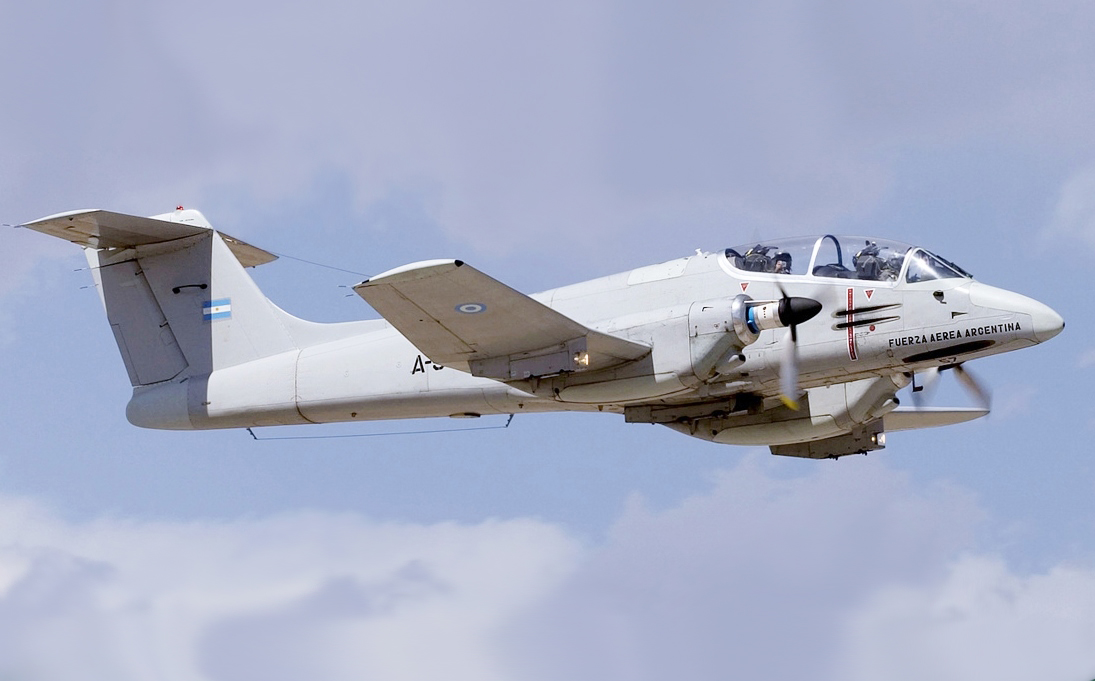
 en.wikipedia.org
http://www.ww2incolor.com/forum/sho...s-war-pictorial.-Post-yours-%A1%A1%A1./page19 (Scroll down to #282)
en.wikipedia.org
http://www.ww2incolor.com/forum/sho...s-war-pictorial.-Post-yours-%A1%A1%A1./page19 (Scroll down to #282)
For those of you who are not familiar with it, AX-04 was a prototype of the IA 58 Pucará, modified during the Falklands War as part of a joint Air Force/Navy project hoping to improve the anti-ship capabilities of operational Pucarás by equipping them with Mark 13 Torpedoes drawn from Naval stocks. The Mark 13, which before the war was in the process of being retired from Argentinean service, had been used primarily by PBY-5A Catalinas, prior to their retirement in 1958, but at the time of the Falklands War, the Armada (Navy) still had a large inventory of Mark 13s, so in May 1982, the FAA (Air Force) decided to try and make use of that fact, with the full co-operation of the Navy, in particular it's Aviation Branch.
Project work began sometime prior to May 21st, 1982. On that date, AX-04 arrived at the FAA's Comandante Espora airbase. AX-04 was originally a series production airframe (A-509), which had being modified into a weapons and systems testbed, post assembly line (pre-war). Prior to the torpedo project, AX-04 had been assigned to the Flight Testing Center at the Area Material Córdoba. The ferry flight was undertaken by two members of the Flight Center, a Capitán Rogelio R. Marzialetti and a (civilian?) Supervisor Mario A. Loiacono. The project though, was actually headquartered (and a lot of the actual work was carried out) at the Navy's Puerto Belgrano base.
Among the initial modifications made to AX-04 for it's role in the project was a film camera to record the torpedo drops. The test torpedoes were carried on it's centerline weapons station.
There were a number of obstacles standing in the way of the project team however. Among them was the fact that it had been so long since the Navy had used airdropped Mark 13s, that both institutional experience with and documentation relating to the use of, the Mark 13 had being lost. This unfortunately included the operational manuals for air deployment. Another problem was both the torpedoes, and the equipment required to operate them from aircraft (e.g. mounting brackets), had been in storage for a long time, especially in the case of the latter, although apparently this didn't prove as much of a problem as feared, reactivation going relatively smoothly for the most part.
The lost documentation and lack of practical experience with the use of the Mark 13 from aircraft proved to be a much bigger problem, as was soon proven by the first test flights.
The first test drop, using a practice round with a inert warhead, took place on the 22nd of May. The Navy had established a test area just off Puerto Madryn, in the Golfo Nuevo, 40 miles from Puerto Belgrano.* The second test took place at the same location later the same day, with the third test drop the day after. All three initial tests were unsuccessful.
The conditions for the first two tests were as follows: Launch involved having the aircraft establish a 20 degree dive, at a speed of 300 knots and at approximately at a height of 100 metres. This, however resulted in the destruction of the torpedo when it impacted the sea surface. The same result occurred the next day when the parameters were changed to a 45deg. dive, speed of 250 knots, and approximate height of 200 metres.
Due to the lack of documentation, all that was known for sure about the conditions for successfully airdropping Mark 13s was that the torpedo should enter the water at an angle of approximately 20 degrees. With a less acute angle, the torpedo would bounce when hitting the water, thus damaging the internal and propulsion mechanisms, and if the angle was greater, then there existed the risk that it would "spike" itself on the bottom of the sea.
Given the urgency of the requirement the project was trying to meet, a solution had to be found, and quickly. With the help of retired sub drivers who had been working at the Navy's torpedo workshops, modifications were made to a number of Mark 13s. These consisted of the installation of a nose-mounted aero-dynamic brake, and of a biplane stabilizer which was installed in the tail end. These additions were designed to break cleanly away from the torpedo body when the torpedo hit the water.
With these modifications in hand, the next round of tests took place on May 24th, and were highly successful. These tests, 7 drops in all, took place while the airplane was on a straight and level flight attitude and at a height of 15 meters. From those tests it was determined that the optimal speed for torpedo drops was 200 knots, since higher speeds caused the torpedo to impact the seabed.
The next round of tests, this one consisting of ten drops with live warshots, took place on June 10th, 1983, at a new location in deeper waters off cliffs North of the Port of Santa Cruz. However this was not as successful as the May 24th tests. By now another Pucará, A566, which was apparently borrowed from a operational unit, had taken over test duties from AX-04, with the latter being assigned to another important project (see below). The problem with the new round of tests was not the change in aircraft, but a seemingly revised requirement to carry out the drops at a speed of 250 knots rather than the 200 knots that proven to be the optimal drop speed. This appears to have been an attempt to improve the survivability of IA-58s in actual torpedo bombing operations, but it backfired. Despite the greater sea depth of the new test area, a number of torpedoes hit the seabed.
Further tests were scheduled for June 14th, in the neighborhood of Pingüino Island (near Puerto Deseado). This location was chosen apparently because it's shoreline and offlying seabed approximated operational conditions around the Falklands (or Malvinas as the Argentineans still refer to them as). While preparations for this new round of tests was taking place though, the entire project was made moot by the final surrender of Argentine forces in the Falklands and the end of the war. The project was terminated and all aircraft and personnel involved were sent back to to their parent units. This included a section of IA-58A Pucara from the Grupo 3 de Ataque of the FAA, who were operating out of the airport of La Plata (Buenos Aires) as part of project security. These particular Pucarás basically acted as ASW spotters, conducting patrols over the approaches to the Río de La Plata, due to the possibility of British submarines operating in the area.
Another project which was running concurrently with the torpedo project was a study into the practicality of deploying Mk.12 anti-shipping mines from Pucarás, in order to mine the San Carlos Straits (Falkland Sound). This project only got to the stage of test fits, at least some of which were carried out on the AX-04, which had just finished it's testbed role in the torpedo project.
*Have to double check this test location!
EDIT2: It looks like the project, or at least the concept for it, first originated around late April, 1982, at the short lived Commando Aereo de Estrategico (Strategic Air Command). See fourth post of this thread for more details.
FMA IA-58 Pucara COIN aircraft.
The Command-in-Chief of the Argentine Air Force officially presented at the beginning of 1968 the requirements to the Cordoba Material Area for the project and construction of the FMA IA-58 Pucará. The construction of the first prototype began in September of the same year, and made its first...


